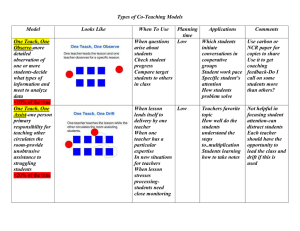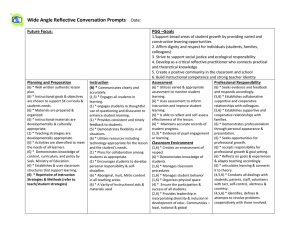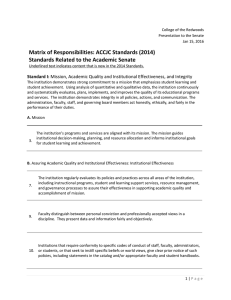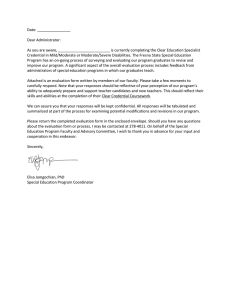Summative Evaluations
advertisement
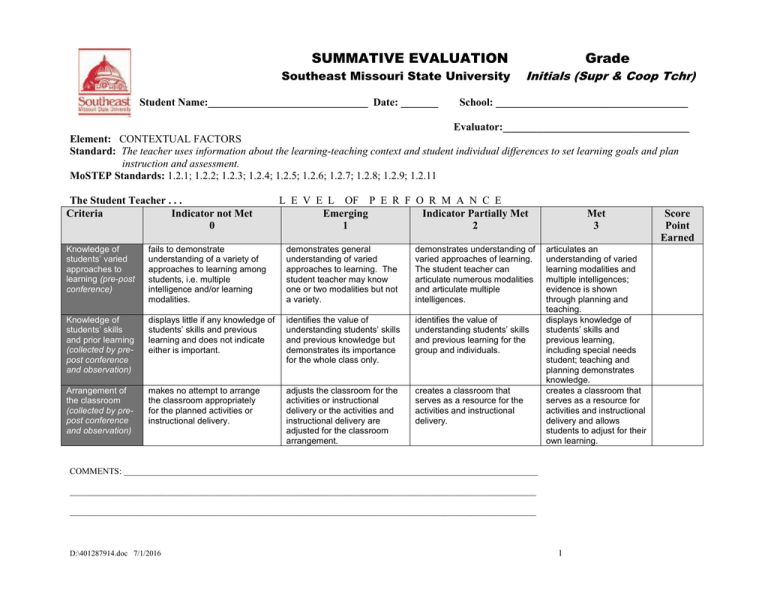
SUMMATIVE EVALUATION Southeast Missouri State University Student Name:______________________________ Date: _______ Grade Initials (Supr & Coop Tchr) School: ____________________________________ Evaluator:___________________________________ Element: CONTEXTUAL FACTORS Standard: The teacher uses information about the learning-teaching context and student individual differences to set learning goals and plan instruction and assessment. MoSTEP Standards: 1.2.1; 1.2.2; 1.2.3; 1.2.4; 1.2.5; 1.2.6; 1.2.7; 1.2.8; 1.2.9; 1.2.11 The Student Teacher . . . Criteria Indicator not Met 0 L E V E L OF P E R F O R M A N C E Emerging Indicator Partially Met 1 2 Knowledge of students’ varied approaches to learning (pre-post conference) fails to demonstrate understanding of a variety of approaches to learning among students, i.e. multiple intelligence and/or learning modalities. demonstrates general understanding of varied approaches to learning. The student teacher may know one or two modalities but not a variety. demonstrates understanding of varied approaches of learning. The student teacher can articulate numerous modalities and articulate multiple intelligences. Knowledge of students’ skills and prior learning (collected by prepost conference and observation) displays little if any knowledge of students’ skills and previous learning and does not indicate either is important. identifies the value of understanding students’ skills and previous knowledge but demonstrates its importance for the whole class only. identifies the value of understanding students’ skills and previous learning for the group and individuals. Arrangement of the classroom (collected by prepost conference and observation) makes no attempt to arrange the classroom appropriately for the planned activities or instructional delivery. adjusts the classroom for the activities or instructional delivery or the activities and instructional delivery are adjusted for the classroom arrangement. creates a classroom that serves as a resource for the activities and instructional delivery. Met 3 articulates an understanding of varied learning modalities and multiple intelligences; evidence is shown through planning and teaching. displays knowledge of students’ skills and previous learning, including special needs student; teaching and planning demonstrates knowledge. creates a classroom that serves as a resource for activities and instructional delivery and allows students to adjust for their own learning. COMMENTS: _______________________________________________________________________________________________ ___________________________________________________________________________________________________________ ___________________________________________________________________________________________________________ D:\401287914.doc 7/1/2016 1 Score Point Earned Element: LEARNING GOALS AND LESSON OBJECTIVES Standard: The teacher sets significant, challenging, varied and appropriate learning goals. MoSTEP Standards: 1.2.1; 1.2.2; 1.2.3; 1.2.4; 1.2.5; 1.2.7; 1.2.8 The student teacher . . . . Criteria Indicator not Met 0 Significance, challenging, and a variety of learning goals (collected by pre-post conference) Appropriateness for all students (collected by prepost conference and observation) Alignment with national, state and/or local goals: Including GLEs if developed for content (collected by pre-post conference) L E V E L OF P E R F O R M A N C E Emerging Indicator Partially Met 1 2 fails to demonstrate evidence of objectives for the lesson. demonstrates lesson objective reflecting a few types of learning. demonstrates that the lesson objectives reflect several types of learning but lacks a significant challenge of thought and expectations. presents goals that are inappropriate for the class. presents goals that are appropriate but fails to meet the needs of the majority of students. fails to develop goals that are aligned with national, state and/or local standards. develops few goals that are aligned with national, state and/or local standards. demonstrates that all of the goals are appropriate for a majority of students but fails to meet learning needs of individual students. develops several goals that are aligned with national, state or local standards and GLEs if developed for the content area. Met 3 demonstrates lesson objectives reveal several types of learning which are significant and challenge thought and expectations. demonstrates that goals take into account the varying learning needs of individuals and groups of students. assures that all goals are aligned with national, state, local standards, and/or GLEs if developed for the content and are articulated through the lesson presentation. COMMENTS: _______________________________________________________________________________________________ ___________________________________________________________________________________________________________ ___________________________________________________________________________________________________________ D:\401287914.doc 7/1/2016 2 Score Point Earned Element: ASSESSMENT Standard: The teacher uses multiple assessment modes and approaches aligned with learning goals to assess student learning before, during and after instruction. MoSTEP Standards: 1.2.3; 1.2.4; 1.2.5; 1.2.7; 1.2.8 The student teacher(s) . . . Criteria Indicator not Met 0 L E V E L OF P E R F O R M A N C E Emerging Indicator Partially Met 1 2 Directions and procedures (collected by observation) gives directions and procedures which are confusing to students. gives directions and procedures which are clarified after initial confusion, or they are excessively detailed. gives directions and procedures which are clear to students and contain an appropriate level of detail. Quality of Questions (collected by observation) poses questions that are poorly stated leading to confused responses or no responses from students. poses questions that are mostly of high quality and require higher order thinking; the questions generate meaningful responses from the students and the teacher provides some response time. Discussion Techniques (collected by observation) interacts with students through predominately recitation; mediates all questions and answers. poses questions that are generally lower quality, focusing primarily on knowledge only with minimal response from students; no response time is provided before moving on to further questions or to lecture. attempts to engage students in a true discussion, but continues to mediate at times. Formal and Informal Assessment has little awareness of formal performance assessment. is aware of various performance assessments but has not used one within the classroom. recognizes the importance of formal and informal assessment; has developed tools for assessment. allows class interactions which represent true discussion, with teacher stepping aside when appropriate. Met 3 gives directions and procedures that are clear to students and anticipates possible student misunderstanding. poses questions that are of high quality requiring higher order thinking; the student teacher allows response time which generates thoughtful answers. supervises students as they assume responsibility for the success of any discussion. uses formal, informal assessments and students’ selfassessments to evaluate student performance and program effectiveness. COMMENTS: ______________________________________________________________________________________________ ___________________________________________________________________________________________________________ D:\401287914.doc 7/1/2016 3 Score Point Earned ___________________________________________________________________________________________________________ Element: DESIGN FOR INSTRUCTION Standard: The teacher designs instruction for specific learning goals, student characteristics and needs, and learning context. MoSTEP Standards: 1.2.1; 1.2.2; 1.2.3; 1.2.4; 1.2.5; 1.2.7; 1.2.8; 1.2.11 The student teacher . . . Criteria Indicator not Met 0 L E V E L OF P E R F O R M A N C E Emerging Indicator Partially Met 1 2 Accurate representation of content (collected by observation) makes content errors or does not correct content errors made by the students. Knowledge of content related pedagogy (collected by observation) displays little understanding of pedagogical issues involved in student learning of the content. displays basic content knowledge but cannot articulate connections with other parts of the discipline or with other disciplines. displays basic pedagogical knowledge but does not anticipate student misconceptions. Use of a variety of instructional activities, assignments and resources develops learning activities which do not follow an organized progression and are not suitable to students or instructional goals. develops some learning activities that are suitable to students or instructional goals but progression of activities in the unit is uneven. Lesson and unit structure (collected by prepost conference and observation) does not clearly define the unit or lesson structure is chaotic; time allocations are unrealistic. provides a lesson or unit that has a recognizable structure, although the structure is not uniformly maintained throughout; most time allocations are reasonable. provides a unit that has a clearly defined structure around which activities are organized; time allocations are reasonable. Instructional material and technology resources includes materials and technological resources that do not support the instructional goals or engage includes some of the materials and technology resources that support the instructional goals, some engaging students in includes materials and technological resources that support the instructional goals, most of which engage students D:\401287914.doc 7/1/2016 displays solid content knowledge and makes connections between the content and other parts of the discipline. displays pedagogical practices that reflect current research on best pedagogical practice with the discipline but without anticipating student misconceptions. develops many learning activities that are suitable to students and instructional goals; progression of activities in the unit is fairly even. Met 3 displays extensive content knowledge. Uses suitable pedagogical practices anticipating student misconceptions and providing necessary corrections. develops learning activities that are highly relevant to students and demonstrates organized progression of activities in the unit. provides a lesson or unit structure which is clear and allows for different pathways according to student needs; time allocation is well-planned and implemented. includes materials and technological resources that engage students in meaningful learning. 4 Score Point Earned (collected by observation) students in meaningful learning. meaningful learning. in meaningful learning. COMMENTS: ______________________________________________________________________________________________ ___________________________________________________________________________________________________________ ___________________________________________________________________________________________________________ Element: CLASSROOM MANAGEMENT Standard: The student teacher uses an understanding of individual and group motivation and behavior to create a learning environment that encourages social interaction, active engagement in learning and self-motivation. MoSTEP Standards: 1.2.5; 1.2.10 The student teacher . . . Criteria Indicator not Met 0 L E V E L OF P E R F O R M A N C E Emerging Indicator Partially Met 1 2 Importance of content (collected by pre-post conference and observation) fails to demonstrate evidence of students committing to the values or quality of their work habits. demonstrates little enthusiasm for the quality of student work. communicates the importance of quality work but with minimal conviction toward students taking responsibility for the work. Management of transitions(collected by observation) allows much time lost during transitions. allows sporadically efficient transitions, resulting in some loss of instructional time. provides tasks for organized group work, and groups are managed so most students are engaged at all times. Expectations (collected by observation) has not established standards of conduct or lacks consistent standards. have established standards of conduct for most situations, and most student seem to understand them. has established standards of conduct that are clear to all students. Monitoring of student behavior (collected by observation) does not monitor student behavior; the student teacher is unaware of students’ behavior. is generally aware of student behavior but may miss the behavior of some students. monitors and is alert to student behavior; redirects misbehavior for productive learning. D:\401287914.doc 7/1/2016 Met 3 conveys genuine enthusiasm for the quality of student work and demonstrates enthusiasm through active participation and attention to detail of lessons. allows groups to work independently and productively engaged with students assuming responsibility for productivity. Establishes standards of conduct that are clear to all students, and the standards are developed with student participation. Monitors behavior in subtle and preventative manner; encourages students monitor their own behavior. 5 Score Point Earned COMMENTS: ______________________________________________________________________________________________ ___________________________________________________________________________________________________________ ___________________________________________________________________________________________________________ D:\401287914.doc 7/1/2016 6 Element: REFLECTION AND TEACHING DISPOSITIONS Standard: The student teacher analyzes the relationship between his or her instruction, disposition, and student learning in order to improve teaching practice. MoSTEP Standards: 1.2.2; 1.2.3; 1.2.5; 1.2.8; 1.2.9; 1.2.10 The student teacher . . . Criteria Indicator not Met 0 L E V E L OF P E R F O R M A N C E Emerging 1 Indicator Partially Met 2 Met 3 Oral and written language (collected prepost conference and during observation) Lesson adjustment (collected prepost conference and during observation) Persistence (collected prepost conference) uses spoken language which is inaudible; written language which is illegible; spoken or written language may contain many grammar and syntax errors. adheres rigidly to an instructional plan, even when a change will clearly improve a lesson. uses spoken language which is audible; written language which is legible; both are used with some errors. uses spoken and written language which is clear and correct. Uses spoken and written language which is correct and expressive, with well chosen vocabulary that enriches the lesson. attempts to adjust a lesson, with mixed results. smoothly makes minor adjustments to a lesson. Successfully makes and assures clarity of the objectives through adjustments to the lesson. either gives up or blames the student or the environment for the student’s lack of success. accepts responsibility for the success of all students but has only a limited repertoire of instructional strategies. persists in seeking effective strategies for students who need help. Accuracy (collected prepost conference) does not know if a lesson was effective or achieved its goals, or profoundly misjudges the success of a lesson. has a generally accurate impression of a lesson’s effectiveness and the extent to which instructional goals and objectives were met. Relationships with colleagues (collected prepost conference) has a negative or non-existent relationship with colleagues. demonstrates cordial relationships with colleagues to meet the duties that the teacher preparation program requires. persists in seeking approaches for students who have difficulty learning, possessing a moderate repertoire of strategies. makes an accurate assessment of a lesson’s effectiveness and the extent to which it achieved its goals and objective, and can cite general references to support the judgment. Demonstrates support and cooperation with colleagues. D:\401287914.doc 7/1/2016 makes a thoughtful and accurate assessment of each lesson’s effectiveness and extent to which it achieved its goals and objectives. Demonstrates a professional and positive attitude of collegial support and cooperation. 7 Score Point Earned Use in future teaching (collect pre-post conference) have no suggestions for how a lesson may be improved for the future. makes general suggestions about how a lesson may be improved. makes a few specific suggestions for improvement of lessons in the future. Family, School and Community Involvement demonstrates little interest in family, school and/or community involvement. is involved when necessary. seeks opportunities to develop relationships with family, school, and/or community. draws on a repertoire of skills, offering specific alternative action, complete with probable successes of different strategies for various lessons. demonstrates professional and positive attitude when working with family, school, and community in support of student learning and wellbeing. COMMENTS: ______________________________________________________________________________________________ ___________________________________________________________________________________________________________ ___________________________________________________________________________________________________________ Supervisor: ________________________ Date: _____ Cooperating Teacher: _________________________ Date:_____ Student Teacher: __________________________________ Date: ______ Student Teachers Program (CIRCLE) : Elementary, Early Childhood, Special Education, Secondary or Middle (Art, English, Math, Music, Science, Social Studies, IT, PE, FACS, Business & Marketing, Foreign Language, Speech/Theater) Overall Comments: D:\401287914.doc 7/1/2016 8

